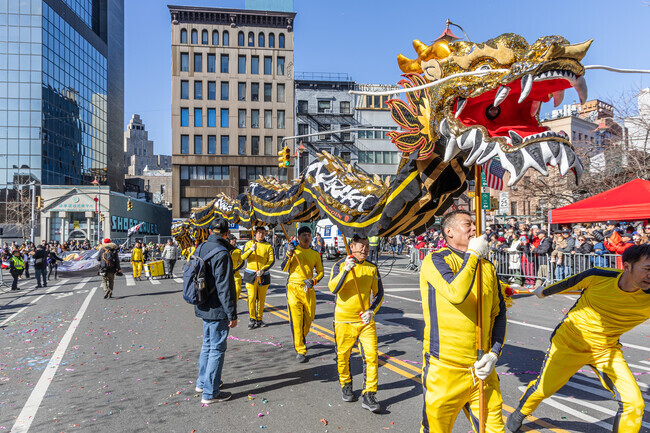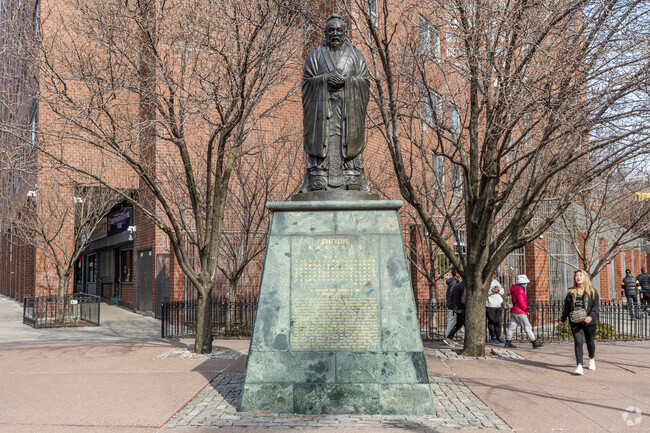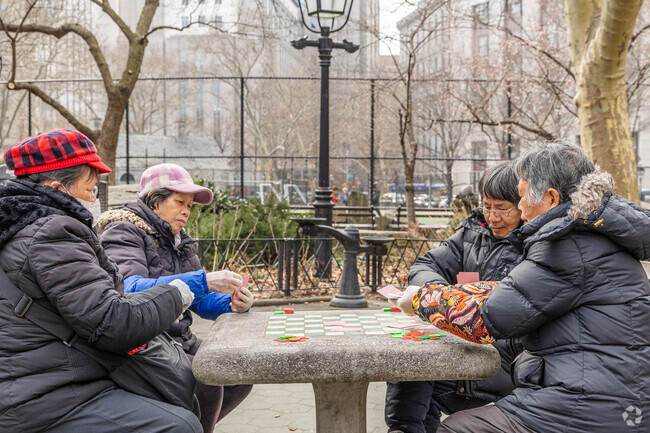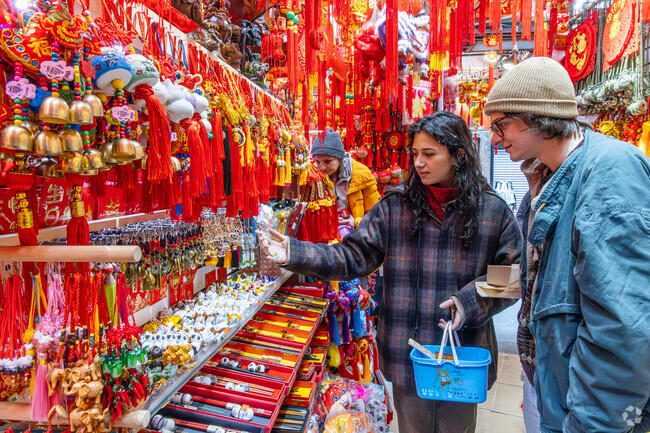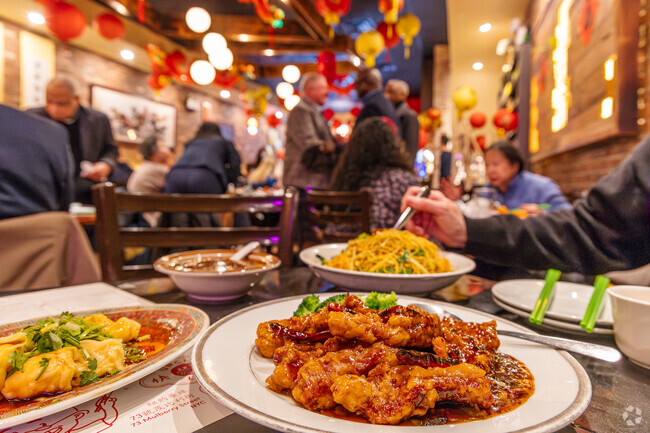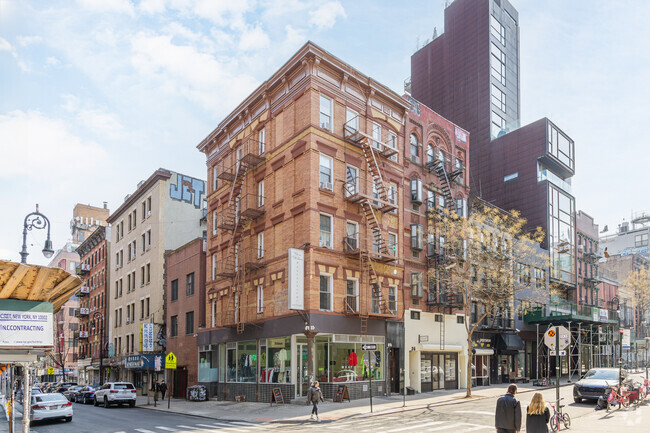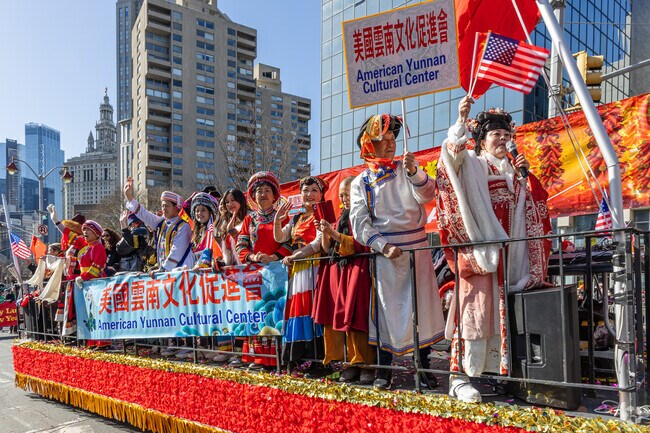Colorful hanging lanterns and twinkling lights above Mott Street mark the entrance to Chinatown. Here savory aromas promise pork buns and dumplings, available in businesses and restaurants dotted throughout the densely packed streets. The area formed by Mott, Bowery, and Bayard Streets comprises the neighborhood’s heart, bustling with noodle, dim sum, and tea shops. Colorful murals pave the path through Doyers Street, the pedestrian walkway that’s home to the century-old Nom Wah Tea Parlor. “Traditionally, Chinatown has stayed the way it has because landowners and building owners there have for generations passed the buildings on to family,” says Jeremy Bolger, native New Yorker and a licensed real estate salesperson with Brown Harris Stevens.
Chinatown
Urban Core Neighborhood in Manhattan, New York
New York County 10002, 10013
A bevy of dining options and Asian grocery stores
The neighborhood offers myriad dining and drinking options, from staples of Cantonese cuisine in restaurants like Uncle Lou to unpretentious cocktails in bars like Whiskey Tavern. Colorful signage punctuates the mixed-use buildings, with ground-floor commercial spaces occupied by bakeries, hair salons, cell phone stores, massage parlors, and souvenir shops. Small fish markets and Asian grocery stores are prevalent, including three floors of shopping and a café in the New Kam Man Grocery Store. More staples and larger chain grocery stores may be found outside the neighborhood’s boundaries. “People come to the neighborhood because the space always connects us,” says Christina Seid, owner of Chinatown Ice Cream Factory, which opened in 1978, serving then-novel ice cream flavors like lychee, green tea and red bean. “Chinatown is about culture. Even if we move away, we still come back and all our families still know each other. A lot of our customers feel connected to the Chinatown space.” Seid notes that the neighborhood is a gathering place where people come to buy goods and food they can only find in Chinatown.
A hotspot for cultural events
The vibrance and energy of the neighborhood is evident year-round, and especially spotlighted during the annual Lunar New Year parade in January or February celebrating Chinese New Year with colorful floats, festivities, and performances. In the summer, night markets spring up featuring local food vendors.
Historic buildings and boutique lofts
One of the oldest residential areas in Manhattan, Chinatown continues to expand, blurring the border with Little Italy. In previous decades, small units could reliably be found in pre-war buildings and prices tended to be less expensive than in nearby neighborhoods like the Lower East Side, SoHo and Tribeca. Today, buyers might find a 500- to 700-square-foot studio or one-bedroom in a historic brick building or postwar mid-rise elevator building with a doorman and roof deck for anywhere from $700,000 to $1.2 million. Rare availability may be found in luxury buildings and towers where two-bedroom condos run roughly $2.5 to $3 million. “It’s definitely a low-lying neighborhood for the most part,” Bolger says, explaining that smaller buildings and tenements comprise most of the housing stock. For instance, the renovated lofts of 17 Orchard Street, originally built in 1900, stand just seven stories.
Columbus Park features a playground and more
While the neighborhood is dense and frenetic at times, a respite can be found in Columbus Park, where residents can join an early morning tai chi group or challenge an opponent to a game of Chinese chess. Featuring a permanent monument honoring the revolutionary Dr. Sun Yat-sen, the park also has a playground, ping pong table, and basketball court for a lunchtime game of hoops.
Subway hub on Canal Street, plus the F and 6 trains
Multiple subway lines converge on Canal Street, with access to the N, Q, R and W at Broadway and the 6 train at Lafayette. The J and Z at Centre Street allows an easy commute to the Financial District. On the neighborhood’s eastern side, the F train at East Broadway and Essex offers a simple route to Dumbo or Midtown. Buttressed to the east by the alluring nightlife of the Lower East Side, and to the north by Little Italy and Nolita, Chinatown’s central location provides easy access to much of Lower Manhattan.
Education for multi-language learners
There are five public schools within Chinatown. PS 124 Yung Wing Elementary School has an A rating from Niche, with its teachers rated A+. MS 131 Dr. Sun Yat Sen Middle School receives an A- from Niche and offers a dual language program in English and Mandarin. Emma Lazarus High School, which focuses on English immersion, has been ranked in the Top 10% for both the best public high school teachers and the most diverse public high schools in New York.
Continuing development causes tensions
A long-planned project replacing the current Manhattan Detention Complex at 125 White Street with a hi-rise jail planned for some 30 stories tall has raised concerns with neighboring business owners apprehensive of the demolition, construction and community impact. Since 2018, the development has been an ongoing source of tension.



Agents Specializing in this Area
-
Neal Young

Neal Young
Brown Harris Stevens Residential Sales LLC
(551) 292-7697
149 Total Sales
2 in Chinatown
$789K - $850K Price Range
-
Bao Ke Zhang
BZ
Bao Ke Zhang
Responds QuicklyEAST COAST NEW YORK
(516) 687-5566
13 Total Sales
1 in Chinatown
$800,000 Price
-
Christian Rogers

Christian Rogers
Elegran LLC
(929) 552-6463
21 Total Sales
5 in Chinatown
$1.5M - $2.1M Price Range
-
Lauren Chao

Lauren Chao
Compass
(848) 281-0851
43 Total Sales
4 in Chinatown
$1.1M - $2.2M Price Range
-
Jessica Chestler

Jessica Chestler
Douglas Elliman Real Estate
(914) 279-2883
59 Total Sales
2 in Chinatown
$2.7M - $3.7M Price Range
-
Anny Yau

Anny Yau
BC Realty Group LLC
(347) 491-6894
9 Total Sales
2 in Chinatown
$828K - $1.2M Price Range
Schools
Interested in learning more about homes in this area? Reach out to , an experienced agent in this neighborhood.
Parks in this Area
Transit
Crime and Safety
| 1 - Low Crime, 10 - High Crime | Chinatown | US |
|---|---|---|
| Homicide | 2 | 4 |
| Sexual Assault | 4 | 4 |
| Assault with Weapon | 4 | 4 |
| Robbery | 5 | 4 |
| Burglary | 3 | 4 |
| Motor Vehicle Theft | 1 | 4 |
| Larceny | 5 | 4 |
| Crime Score | 4 | 4 |
Source: WhatIsMyCrimeRisk.com
Demographics and Home Trends
On average, homes in Chinatown, Manhattan sell after 77 days on the market compared to the national average of 47 days. The average sale price for homes in Chinatown, Manhattan over the last 12 months is $1,851,636, up 30% from the average home sale price over the previous 12 months.
Home Trends
Home Facts
Open Houses
-
Sunday, Apr 272 - 3pm

-
Sunday, Apr 272 - 3pm

-
Sunday, Apr 272 - 3pm

Distribution of Home Values
Homes for Sale
Homes for Rent
Interested in learning more about homes in this area? Reach out to , an experienced agent in this neighborhood.
Average Home Value
Property Mix - Square Feet
This Neighborhood Has More Renters
Demographics
Finances
Education and Workforce
Weather
Area Factors
Biker's Paradise
Bike Score®
Walker's Paradise
Walk Score®
Rider's Paradise
Transit Score®
Sound Score® measures the noise level of any address. Transit Score® measures access to public transit. Bike Score® measures the bikeability of any address.
Nearby Neighborhoods

Trendy downtown neighborhood with dynamic nightlife

Buzzy nightlife mixed with a rich creative history

Historic housing complexes, hand-pulled noodles and condos between iconic bridges

Busy government district with historical architecture and parks

NYC neighborhood with a "style, rhythm and culture all its own"

Historic, loft-style living with a booming restaurant and shopping scene

